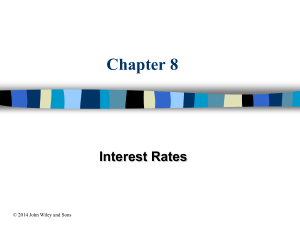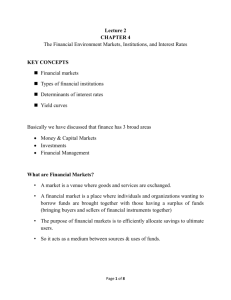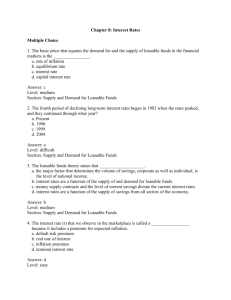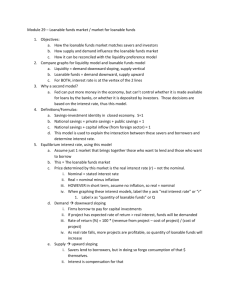Chapter 9
advertisement
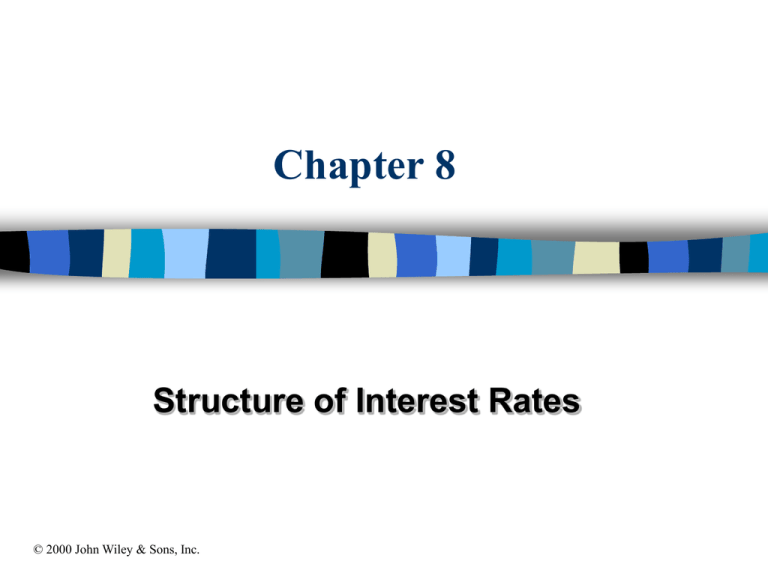
Chapter 8 Structure of Interest Rates © 2000 John Wiley & Sons, Inc. Chapter Outcomes Describe how interest rates change in response to shifts in the supply and demand for loanable funds Identify major historical movements in interest rates in the United States Describe what is meant by the loanable funds theory of interest rates 2 Chapter Outcomes (Continued) Identify the major determinants of market interest rates Describe the types of marketable securities issued by the U.S. Treasury Describe the ownership of Treasury securities and the maturity distribution of the federal debt 3 Chapter Outcomes (Continued) Explain what is meant by the term or maturity structure of interest rates Identify and briefly describe the three theories used to explain the term structure of interest rates Identify broad historical price level changes in the U. S. and other economies and discuss their causes 4 Chapter Outcomes (Concluded) Describe the various types of inflation and their causes Discuss the effect of default risk premiums on the level of long-term interest rates 5 Basic Interest Rate Concepts INTEREST RATE: Price that equates the demand for and supply of loanable funds ROLE OF FINANCIAL MARKETS: Interest rates are determined by the supply and demand for loanable funds in financial markets 6 Historical Changes in U.S. Interest Rate Levels: Periods of Rising Interest Rates 1864-1873 (rapid economic expansion after the Civil War) 1905-1920 (pre-war expansion and World War I-related inflation) 1927-1933 (economic boom in late 1920s followed by major depression) 1946-early 1980s (rapid economic expansion after World War II) 7 Historical Changes in U.S. Interest Rate Levels: Periods of Falling Interest Rates 1873-1905 (supply of funds exceeded demand for funds and prices fell) 1920-1927 (rapid growth in supply of funds and falling prices) 1933-1946 (actions taken to fight the depression and finance World War II) Since early 1980s (generally declining prices and interest rates) 8 Loanable Funds Theory DEFINITION: States that interest rates are a function of the supply of and demand for loanable funds SOURCES OF LOANABLE FUNDS: --current savings --expansion of deposits by depository institutions 9 Interest Rate Determination in the Financial Markets A B S1 S1 8% 7% D1 D1 Quantity of Loanable Funds S2 D2 Quantity of Loanable Funds S1 S2 9% S1 8% D1 Quantity of Loanable Funds C D3 D1 Quantity of Loanable Funds D 10 Factors Affecting the Supply of Loanable Funds Volume of Savings Expansion of Deposits by Depository Institutions Liquidity Attitudes 11 Determinants of Market Interest Rates NOMINAL INTEREST RATE (R): Interest rate that is observed in the marketplace BASIC EQUATION: r = RR + IP + DRP REAL RATE OF INTEREST (RR): Interest rate on a risk-free debt instrument when no inflation is expected 12 Determinants of Market Interest Rates (Continued) BASIC EQUATION: r = RR + IP + DRP INFLATION PREMIUM (IP): Average inflation rate expected over the life of the security DEFAULT RISK PREMIUM (DRP): Compensation for the possibility of the borrower’s failure to pay interest and/or principal when due 13 Determinants of Market Interest Rates (Concluded) BASIC EQUATION EXPANDED: r = RR + IP + DRP + MRP + LP MATURITY RISK PREMIUM (MRP): Compensation expected by investors due to interest rate risk on debt instruments with longer maturities LIQUIDITY PREMIUM (LP): Compensation for securities that cannot easily be converted to cash 14 without major price discounts Interest Rate Risk DEFINITION: Possible price fluctuations in fixedrate debt instruments associated with changes in market interest rates REASON: An inverse relationship exists between debt instrument values or prices and nominal interest rates in the marketplace 15 Risk-Free Rate of Interest DEFINITION: Interest rate on a debt instrument with no default, maturity, or liquidity risks (Treasury securities are the closest example) EQUATION: Risk-Free Rate = Real Rate (RR) + Inflation Premium (IP) 16 Two Types of U.S. Government Debt Obligations MARKETABLE GOVERNMENT SECURITIES: Securities that may be bought and sold through the usual market channels NONMARKETABLE GOVERNMENT SECURITIES: Issues that cannot be transferred between persons or institutions but must be redeemed with the U.S. government 17 Types of U.S. Treasury Debt Obligations TREASURY BILLS: Obligations that bear the shortest (up to one year) original maturities TREASURY NOTES: Obligations issued for maturities of one to ten years TREASURY BONDS: Obligations of any maturity but usually over five years 18 Term or Maturity Structure of Interest Rates TERM STRUCTURE: Relationship between interest rates or yields and the time to maturity for debt instruments of comparable quality YIELD CURVE: Graphic presentation of the term structure of interest rates at a given point in time 19 Three Term Structure Theories EXPECTATIONS THEORY: Shape of the yield curve indicates investor expectations about future inflation rates LIQUIDITY PREFERENCE THEORY: Investors are willing to accept lower interest rates on short-term debt securities which provide greater liquidity and less interest rate risk 20 Three Term Structure Theories (Continued) MARKET SEGMENTATION THEORY: Interest rates may differ because securities of different maturities are not perfect substitutes for each other 21 Inflation Premiums and Price Movements INFLATION: Occurs when an increase in the price of goods or services is not offset by an increase in quality HISTORICAL PRICE MOVEMENTS: Changes in the money supply or in the amount of metal in the money unit have influenced prices since the earliest records of civilization 22 Periods of Inflation in the U. S. Revolutionary War War of 1812 Civil War World War I World War II Postwar Period through Early 1980s 23 Types of Inflation COST-PUSH INFLATION: Occurs when prices are raised to cover rising production costs, such as wages DEMAND-PULL INFLATION: Occurs during economic expansions when demand for goods and services is greater than supply 24 Types of Inflation (Continued) SPECULATIVE INFLATION: Caused by the expectation that prices will continue to rise, resulting in increased buying to avoid even higher future prices ADMINISTRATIVE INFLATION: The tendency of prices, aided by union-corporation contracts, to rise during economic expansion and to resist declines during recessions 25 Default Risk Premiums DEFAULT RISK: Risk that a borrower will not pay interest and/or repay the principal on a loan according to the agreed contractual terms BASIC EQUATION: DPR = r - RR - IP BASIC EQUATION EXPANDED: DPR = r - RR - IP - MRP - LP 26 Default Risk Premium Example BASIC INFORMATION: nominal interest rate = 9%; real rate = 3%; inflation premium = 5%; and market risk and liquidity premiums = 0%. What is the default risk premium? EXPANDED EQUATION: DRP = r - RR - IP - MRP - LP DPR = 9% - 3% - 5% - 0% - 0% = 1% 27
